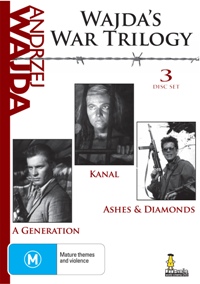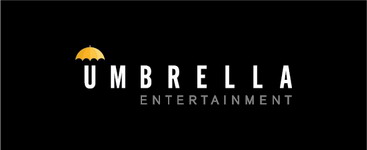A Generation (1955) |
|
A Generation (1955) |
|


|
| BUY IT |
| General | Extras | ||
| Category | Drama |
Interviews-Crew-An Interview with Director Andrzej Wajda Trailer-Open City by Roberto Rosellini Trailer-Closely Observed Trains by Jiri Menzel Trailer-Europa Europa by Agnieszka Holland Trailer-The Thief by Pavel Chukhrai |
|
| Rating |

|
||
| Year Of Production | 1955 | ||
| Running Time | 83:11 | ||
| RSDL / Flipper | No/No | Cast & Crew | |
| Start Up | Ads Then Menu | ||
| Region Coding | 4 | Directed By | Andrzej Wajda |
|
Studio
Distributor |
 Umbrella Entertainment |
Starring |
Tadeusz Lomnicki Urszula Modrzynska Tadeusz Janczar Janusz Paluszkiewicz Ryszard Kotys Roman Polanski Ludwik Benoit Zofia Czerwinska Zbigniew Cybulski Tadeusz Fijewski Zygmunt Hobot Cezary Julski |
| Case | Amaray-Transparent-S/C-Dual | ||
| RPI | Box | Music | Andrzej Markowski |
| Video | Audio | ||
| Pan & Scan/Full Frame | Full Frame | Polish Dolby Digital 2.0 (192Kb/s) | |
| Widescreen Aspect Ratio | None | ||
| 16x9 Enhancement | No | ||
| Video Format | 576i (PAL) | ||
| Original Aspect Ratio | 1.33:1 | Miscellaneous | |
| Jacket Pictures | No | ||
| Subtitles | English | Smoking | Yes |
| Annoying Product Placement | No | ||
| Action In or After Credits | No | ||
A Generation is the first film of three films directed by Andrzej Wajda during the 1950s that focuses on the Polish reaction to Nazi occupation during World War II. The Australian distributor, Umbrella Entertainment has released these three films in a boxset entitled Wajda's War Trilogy, making these important films available for the first time for Region 4 collectors. These films mark the beginning of a movement in cinema called the Polish Film School which led to other Polish directors, cinematographers and actors getting wider recognition in the late 1950s and early 1960s. The actual film school opened in 1948 in Lodz, Poland and the film school was influenced by Italian Neorealism, a movement of cinema which emphasised real life events and the use of non-professional actors during the late 1940s and early 1950s (The Bicycle Thieves by Vittorio de Sica and Rome, Open City by Roberto Rossellini are the two most idealistic films of this era).
This film marked Wajda's film debut. In fact, the cast and crew were mainly all newcomers, all coming from the film school in Lodz, with only actors Tadeusz Lomnicki and Tadeusz Janczar having appeared in a film before. The film is a homage to the Italian Neorealist movement, with Wajda depicting the struggle for ordinary Polish youth and their resistance to Nazi occupation during World War Two. The events of the film take place in 1942, but of significance is the relief support for the Jewish ghetto which turned into the 1943 Warsaw Ghetto Uprising, the largest united Jewish resistance to Nazi oppression during the war. This resistance lasted three months before being crushed in April, 1943 and most cinema fans would know of it from its brutal depiction in Roman Polanski's 2002 film, The Pianist.
In fact, Roman Polanski made his film debut as an actor in this film, it is quite a revelation to see him in it and to contrast it to similar events depicted in his aforementioned Oscar-winning 2002 film. A Generation was made to celebrate 10 years of Communist government in 1955 so the conflict between sympathisers for the nationalist home army who supported the Polish government-in-exile in London and the communists (the youthful resistance depicted in the film) can be better understood as an analogy for the future direction of Poland after World War Two.
Zbigniew Cybulski, who plays Kostek in the film, appears only briefly at the beginning but would play an iconic role in the final film of the trilogy, Ashes and Diamonds.
The transfer of this film is very poor. The original source has visible damage, numerous white artefacts from dust on the film, scratches (possibly from dirt) and reel change markings.
The Aspect Ratio is 1:33:1 fullscreen.
The film is slightly soft throughout, however contrast between light and dark scenes is impressive considering that this was Director of Photography Jerzy Lipman's first film.
A Generation was shot in black and white (as were all the films in the Wajda's War Trilogy boxset) but the contrast mentioned previously really highlights the tones.
The film is presented on a single layer disc with a 41 minute interview as the main extra. This means that the film only occupies 2.6gb of space on the DVD and although it is only 83 minutes in length, it does explain why the average bitrate is only 4.3 Mb per second, which is fairly low. This accounts for the soft look of the film. There is significant scratches present in the transfer at the 60:00 mark and telecine wobble is evident in the beginning credit sequence and at the 76:00 minute mark also.
Subtitles are in white and do not stand out.
There is no RSDL change because the film is presented on a single layer disc.
| Sharpness | |
| Shadow Detail | |
| Colour | |
| Grain/Pixelization | |
| Film-To-Video Artefacts | |
| Film Artefacts | |
| Overall |
There is one audio track in Polish Dolby Digital 2.0 Mono encoded at 192 bps.
The dialogue is clear throughout, audio is synchronised but the audio does drop out at around the 53:00 minute mark intermittently for about a minute. The soundtrack also contains background hiss as a result of the unrestored film source used for this DVD transfer.
The soundtrack is subtle and supports the action on-screen, especially during the dramatic sequences involving the German soldiers and the Polish youth resistance.
There is no Surround Channel Usage as the movie is in mono, spread out over 2 front speakers.
There is also no usage of the Subwoofer.
| Dialogue | |
| Audio Sync | |
| Clicks/Pops/Dropouts | |
| Surround Channel Use | |
| Subwoofer | |
| Overall |
NOTE: To view non-R4 releases, your equipment needs to be multi-zone compatible and usually also NTSC compatible.
A Generation has been released in Region 2 (United Kingdom) and Region 1 (USA).
The Region 2 UK release is identical to the Region 4 release.
The Region 1 Criterion US release has a transfer that is soft but does not contain as many artefacts as the Region 2 and Region 4 release. It contains the following extras:
*Andrzej Wajda: On Becoming a Filmmaker, an exclusive interview with the director and film critic Jerzy Plazewski (33:38) 16x9 enhanced.
*Ceramics from Ilza (Ceramika Ilzecka), Wajda’s 1951 film school short (9:47)
*Behind-the-scenes production photos, publicity stills, posters, and original artwork by the director and an essay by film scholar Ewa Mazierska.
The Region 1 Criterion release has a better transfer and extras than the Region 2 and Region 4 releases.
If you can overlook the poor transfer, you can appreciate this homage to Italian Neorealism and the struggle of Polish resistance in World War Two. Region 4 cinema lovers can be thankful that Umbrella Entertainment have released this boxset of films, an important part of film history, highlighting the Polish Film School movement of the 1950s and 1960s leading to the development of great Polish directors such as Roman Polanski and Krzysztof Kieslowski. The Region 1 Criterion release has undergone a restoration (although not complete and comprehensive) and has different extras and is the reference DVD release. The Region 4 release is still a good release for Region 4 collectors and is much cheaper than the Region 1 release at the time of writing this review.
| Video | |
| Audio | |
| Extras | |
| Plot | |
| Overall |
| Review Equipment | |
| DVD | Sony BDP-S550, using HDMI output |
| Display | Samsung LA46A650 46 Inch LCD TV Series 6 FullHD 1080P 100Hz. Calibrated with THX Optimizer. This display device is 16x9 capable. |
| Audio Decoder | Sony STR-K1000P. Calibrated with THX Optimizer. |
| Amplification | Sony HTDDW1000 |
| Speakers | Sony 6.2 Surround (Left, Front, Right, Surround Left, Surround Back, Surround Right, 2 subwoofers) |